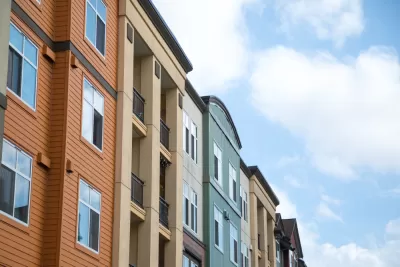The "political compass" idea can easily be applied to explain differing philosophies about urban development.

One idea that seems to have become widespread online is the political compass, a graph dividing political ideologies into four groups: Authoritarian Left (left-wing economically, but socially conservative and/or favoring a strong state), Libertarian-Left (also economically leftish, but more pro-civil liberties), Authoritarian Right (economically and socially conservative, generally favoring activist government in order to ensure law and order), and Libertarian Right (economically conservative, socially tolerant).
It seems to me that the political compass is easy to adapt to arguments about urbanism. For example, one axis of conflict is "status quo vs. YIMBY"- people who favor lots of new housing (colloquially referred to as "YIMBYs") vs. people who favor the zoning status quo. Another axis of conflict is "Sprawl vs. Smart Growth"—people who view additional suburbanization as essentially harmless vs. people who view it as environmentally or socially harmful.
So for example, a libertarian purist would be at the "YIMBY/Sprawl" extreme, because a pure libertarian would believe that a) government has no business limiting the housing supply but b) also has no business limiting sprawl. For example, market urbanist Scott Beyer is somewhere in this quadrant; he values the benefits of urban life and supports new infill housing, but views suburban development as a legitimate consumer choice that should not be overly restricted.
On the other hand, Todd Litman (who has written extensively on the Planetizen blog) is perhaps in the “YIMBY/Smart Growth” column; he has written extensively about the benefits of more walkable development, but has also discussed the importance of new housing supply in holding down housing costs. I am instinctively sympathetic towards this group, although in regions with housing shortages, I am more willing than I used to be to support additional suburban housing.
The "Status Quo*/Smart Growth" grouping seems to be very popular among older urbanists. The core idea animating this group is that even though sprawl is environmentally harmful, new infill development should still be carefully regulated. The major constituency for this group is older urban homeowners, who benefit from rising home prices, and who see no obvious benefit from new housing in their neighborhoods. Members of this group seem to be motivated by a variety of concerns, such as fear of gentrification, fear of low-quality architecture, and dislike of tall buildings. Others simply are unwilling to believe that the law of supply and demand applies to market-rate housing. More moderate members of this grouping claim to favor new housing is long as it is "affordable" (i.e. subsidized so it can cater to low- and moderate- income urbanites).
The "Status Quo/Sprawl" grouping tends not to have as much support among planning commentators as the other three groupings, but is arguably popular among suburban homeowners and the politicians who represent them. People in this grouping are perfectly happy with suburbia the way it is, and fear that new housing might bring a variety of unwelcome change. They tend to favor new housing, as long as it is low-density sprawl. President Trump’s claims that he was protecting suburbia from civil rights laws was an attempt to cater to this group; similarly, sprawl advocate Joel Kotkin has criticized attempts to add density to existing neighborhoods.
I also note that the two "status quo" groups share a variety of concerns: both urban and suburban opponents of new housing fear that new housing might bring increased traffic, limit automobile parking, or otherwise stress infrastructure.
It also seems to me that the two "status quo" groups tend to be more politically extreme than the two “YIMBY” groupings: in my experience, YIMBYs tend to be center-left, while right-wingers and socialists tend to be more skeptical of new housing. In New York, the most "YIMBY" candidate was moderate Democrat Kathryn Garcia, while both the leading Republican and the more left-wing candidates tended to favor more obstacles to non-subsidized housing. However, I do not know if New York City is typical of the nation in this regard, so perhaps I am overgeneralizing here.
*More colloquially, NIMBY (Not In My Back Yard). However, this term is a bit underinclusive, since some people seem to be against new housing in anyone's back yard.

Study: Maui’s Plan to Convert Vacation Rentals to Long-Term Housing Could Cause Nearly $1 Billion Economic Loss
The plan would reduce visitor accommodation by 25,% resulting in 1,900 jobs lost.

North Texas Transit Leaders Tout Benefits of TOD for Growing Region
At a summit focused on transit-oriented development, policymakers discussed how North Texas’ expanded light rail system can serve as a tool for economic growth.

Using Old Oil and Gas Wells for Green Energy Storage
Penn State researchers have found that repurposing abandoned oil and gas wells for geothermal-assisted compressed-air energy storage can boost efficiency, reduce environmental risks, and support clean energy and job transitions.

Santa Barbara Could Build Housing on County Land
County supervisors moved forward a proposal to build workforce housing on two county-owned parcels.

San Mateo Formally Opposes Freeway Project
The city council will send a letter to Caltrans urging the agency to reconsider a plan to expand the 101 through the city of San Mateo.

A Bronx Community Fights to Have its Voice Heard
After organizing and giving input for decades, the community around the Kingsbridge Armory might actually see it redeveloped — and they want to continue to have a say in how it goes.
Urban Design for Planners 1: Software Tools
This six-course series explores essential urban design concepts using open source software and equips planners with the tools they need to participate fully in the urban design process.
Planning for Universal Design
Learn the tools for implementing Universal Design in planning regulations.
Ascent Environmental
Borough of Carlisle
Institute for Housing and Urban Development Studies (IHS)
City of Grandview
Harvard GSD Executive Education
Toledo-Lucas County Plan Commissions
Salt Lake City
NYU Wagner Graduate School of Public Service



























